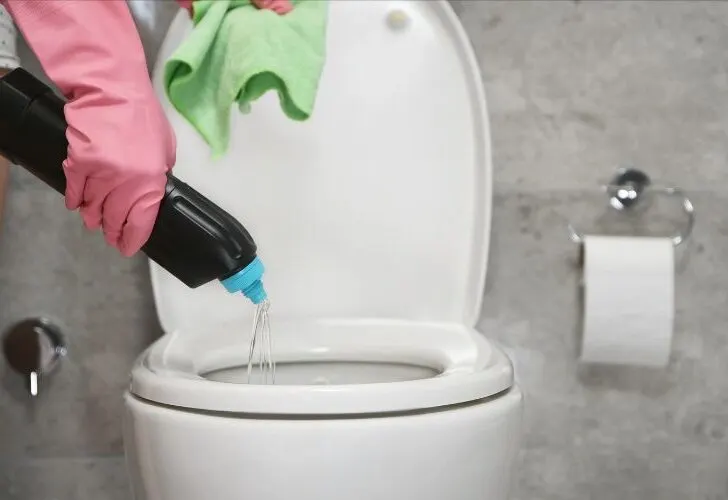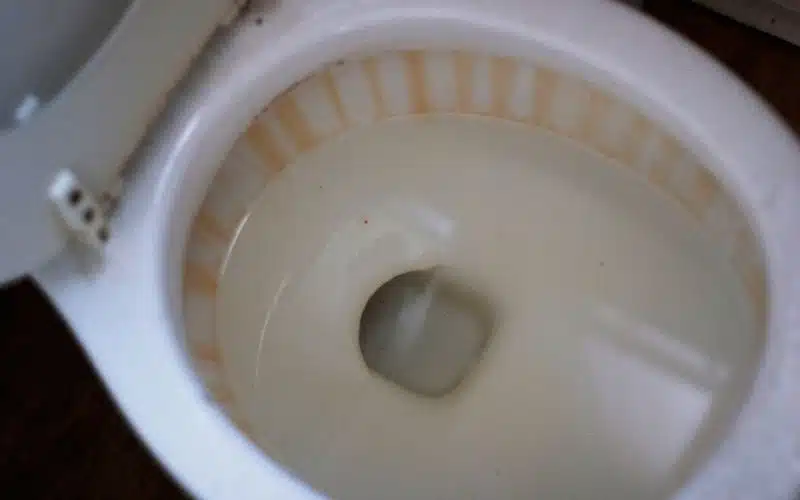A clean toilet says a lot about your home. A clean and hygienic toilet is excellent for a good bathroom experience.
Cleaning the toilet can be difficult, especially with the wrong cleaning agent. However, knowing what product to use will give you a pleasant bathroom experience.
Vinegar cannot damage your toilet bowl. Vinegar is a natural and biodegradable product that is safe for septic tanks and toilet bowls. Dirt and stains often get on the toilet bowl and sometimes on the seat, tank, and other components. Adding vinegar to the toilet bowl ensures the toilet is clean and not clogged with deposits.
Does Vinegar Cause Damage to Toilet Bowls?

Vinegar does not cause damage to toilet bowls. Vinegar is from acetic acid, which makes it a natural disinfectant.
Vinegar is the perfect product to clean your toilet bowls and tank. Fortunately, vinegar is an excellent alternative to most strong cleaning agents.
Most commercial cleaning agents contain Bleach which can cause adverse effects on the health of toilet users.
Not only does vinegar helps to clean the dirt and stains, but it also helps to neutralize the smell of the toilet.
Vinegar has high antimicrobial quality making it a perfect cleaning agent in the bathroom. Because it contains about 20% acetic acid, it can kill germs, molds, and bacteria.
In addition, you can use vinegar to clean all types of toilets. It works well on porcelain types as it works well for other types.
Apart from using it to clean the toilet, you can also use vinegar to clean the shower and tiles in the bathroom and toilet.
Other uses of vinegar in homes include:
- Removing odors from cloth and laundry equipment
- Killing mildew
- Clarification of glass
- Removing stains from a dishwasher
- Removing tarnish from metals
A few cups of white or distilled vinegar can give your toilet the cleanliness it deserves.
To get a clean toilet, you need baking soda, an old toothbrush, gloves, a toilet scrub, a mask, and vinegar.
Below are the steps that show how you can use vinegar to get a white, sparkling toilet bowl:
- Take necessary precautions by wearing masks and gloves to protect yourself from acidic vinegar.
- Form a paste by mixing vinegar and baking soda thoroughly with each other. There will be bubbles during the first few seconds in the mixture. However, if this does not happen, the baking soda might be inactive.
- If you prefer a particular fragrance, you can put essential oils into the mixture and mix.
- Apply the mixture to the toilet bowl with the toothbrush, fully concentrating on stains and dirty areas.
- Leave the mixture for about 15 minutes and allow it to dry up
- After the mixture has dried up, flush the toilet to rinse the mixture away.
- Repeat the process until the toilet looks clean and all stains are no longer visible.
Can I Leave the Vinegar in the Toilet Overnight?
You can leave the vinegar in the toilet overnight. This method is suitable for the removal of tough stains. It also works well for clogs and mineral build-up.
Throughout the night, the clogs and build-up soften and becomes easy to wash away. In the morning, flush the toilet, and you will see a clean toilet.
For dirty toilet tanks, flush the toilet to ensure it is empty, then fill it with undiluted vinegar and allow it to stay overnight.
What Kind of Vinegar Do You Use in a Toilet?
White vinegar is suitable for cleaning the toilet. When there is no alternative, apple cider can do the same work as white vinegar.
Most people spray apple cider in the toilet bowl and flush after 15 minutes for effective cleaning. You can also put a cup of apple cider vinegar in the toilet bowl and flush it after some minutes.
However, people rarely use apple cider vinegar because the color can stain the toilet bowl. You can also use distilled vinegar, which is more precise than white vinegar.
Below are the differences between white vinegar and distilled vinegar:
| White Vinegar | Distilled Vinegar |
|---|---|
| It is also called spirit vinegar | It is also called the virgin vinegar |
| It is from acid fermentation of sugarcane | It is from various products such as honey, coconut, rice, and apple cider |
| It has a higher percentage of acidity than distilled vinegar | It has a lesser percentage of acidity than white vinegar |
During acid fermentation, the chemicals in sugar cane undergo oxidation to become more acidic.
Therefore, you can also get white by mixing acetic acid with water. However, white vinegar from this method has a sourer taste compared to the one from the acid fermentation of sugarcane.
Since white vinegar has about 20% acetic acid, you can also use it as a preservative in cakes and food items.
It is also used in the laboratory to produce drugs and other medicinal purposes. In addition, you can use it in pet houses as an herbicide or antimicrobial.
Fortunately, it does not leave any foul or pungent smell after use because it does not contain ammonia.
On rare occasions, you can also use another type of vinegar called distilled malt vinegar to remove stains. It is perfect for removing hard water stains.
However, it is highly acidic, with a PH level of 2.5. Places with hard water use distilled malt vinegar because it neutralizes limescale and residue from hard water.
However, this type of vinegar is not best for cleaning the toilet because it leaves brown stains on the toilet bowl.
What Cleaners Can You Use for Your Toilet Bowls?
Cleaning the toilet seems complicated, but with suitable cleaning agents, you can get the clean, sparkling look you want.
There are various cleaners you can use for your toilet bowls, and below are some of them:
#1. Toilet Bowl Cleaning Tablet
Cleaning tablets allow you to have a clean toilet after every use. Drop a tablet in the toilet bowl and allow it to stay 5 minutes before flushing.
This tablet effectively kills germs and harmful bacteria, such as the popular Escherichia Coli.
When it comes in contact with water, the tablet dissolves and releases its active ingredient, Bleach. You can also scrub the toilet bowls to remove stubborn stains and grease.
- EFFECTIVE IN CLEANING - Effectively help you clean...
- LONG-LASTING - Each toilet cleaner tablet lasts up...
- HOW TO USE - DO NOT tear off the blue outer...
- POINTS FOR ATTENTION - When the blue toilet bowl...
Last update on 2024-01-06 / Affiliate links / Images from Amazon Product Advertising API
#2. Disinfecting Bleach
With so many positive reviews online, you can guarantee that this disinfectant will give your toilet a new look.
It is perfect for homeowners with a tight budget. Disinfecting Bleach can get rid of both bacteria and viruses. Ultimately, it brightens up your toilet and keeps your toilet bowl white.
- Clean, disinfect, and deodorize with the power of...
- For use in HE and standard washing machines
- A registered disinfectant that kills up to 99.9...
- Excellent antibacterial, germicidal and fungicidal...
Last update on 2024-01-06 / Affiliate links / Images from Amazon Product Advertising API
#3. Hydrogen Peroxide Toilet Bowl Cleaner
Over time, hydrogen peroxide cleans toilets effectively. It effectively removes limescale, grease, and challenging and stubborn stains.
To use, pour half of a cup into the toilet bowl and flush after 25minutes. You can then use a brush to clean and flush other stains again.
However, it can irritate the eyes when it comes to contact with them. In addition, it reacts readily with other chemicals because it is an excellent oxidizer.
- KILLS 99.9% OF BATHROOM BACTERIA: Lysol 0% Bleach...
- HYDROGEN PEROXIDE BASED FORMULA, 0% BLEACH*:...
- CUTS HROUGH LIMESCALE AND SOAPCSUM : Lysol 0%...
- MULTI PUPROSE BATHROOM CLEANING: This powerful...
Last update on 2024-01-06 / Affiliate links / Images from Amazon Product Advertising API
#4. Hydrochloric Acid Toilet Cleaner
Hydrochloric acid is one of the toilet cleaning agents that is effective in giving fast results.
It dissolves stains, limescale, and mineral build faster than most other toilet cleaners. In addition, hydrochloric acid can remove clogs from drains and pipes.
However, it would help if you used hydrochloric with caution because it is highly corrosive and can cause skin damage when applied to the skin.
Also, you should wear safety gear such as durable gloves and masks during application.
#5. Chlorine Bleach
Chlorine is a household cleaning agent familiar to most house owners. Bleach removes stains and kills bacteria.
However, unlike vinegar, you should not mix chlorine bleach with any other cleaning agent during application.
Chlorine bleach can produce toxic fumes when mixed with other cleaning agents, such as ammonia.
However, diluting the concentration before use would be best to reduce the harshness of your toilet bowls and other parts.
Also, safety gear such as durable gloves, goggles, and masks should be worn during application to prevent toxic fumes from getting to the eyes and other sensitive body parts.
#6. Toilet Wipes Dispenser
Toilet wipes Dispenser has dry and wet wipes that you can use to clean the toilet bowls and other parts of the toilet.
You can use the wipes with foamy soaps to get a perfect toilet. However, the wipes should be appropriately disposed of to avoid the blockage of the drains and pipes.
You can dispose of them in a trash can. Also, ensure you are fully covered in safety gear to avoid splashing the toilet water into your eyes when wiping.
#7. Antibacterial Cleaning Agents
It is not uncommon not to find germs in the toilets. Hence, using an antibacterial cleaning agent on them is a good way of getting rid of them.
In addition, some house owners use bacteria spray across the toilet, especially on the lid and toilet bowls.
Therefore, these bacteria sprays should be left on these parts to have a long-lasting effect on the toilet.
Apart from getting rid of germs in the toilet, these antibacterial sprays can help prevent bacteria and germs after cleaning.
Conclusion
Getting a clean toilet is not impossible with the proper cleaning agent. Vinegar is known to be a good toilet cleaning agent when appropriately applied.
It is a natural disinfectant made from acetic acid, which does not damage bowls. However, it would be best if it is appropriately applied to get the best result.











